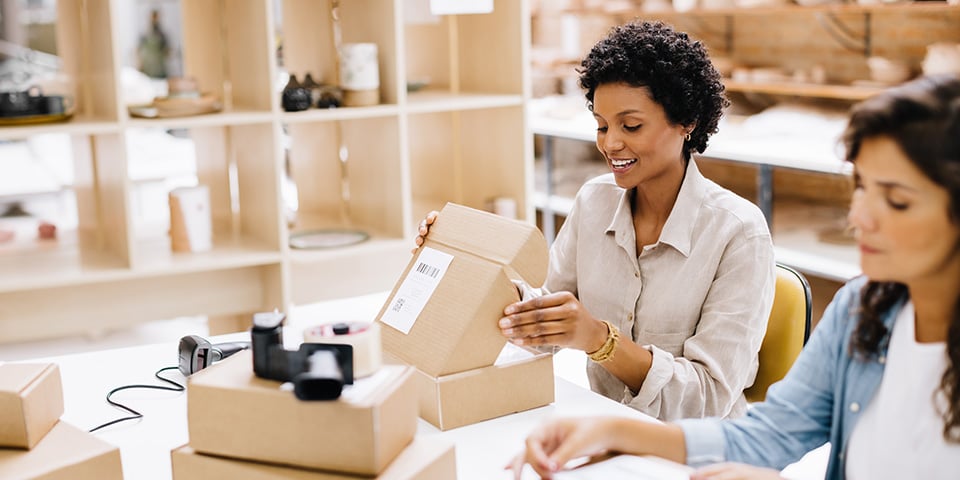Of the many retail dynamics to spring forth from the pandemic, one has shown unreliable staying power: Fulfilling e-commerce orders from retail stores rather than warehouses. Ship-from-store fulfillment is expected to reach $140.96 billion by 2024, driven by sky-high e-commerce order volumes and customer expectations for speedy deliveries.
Like all emerging trends, ship-from-store fulfillment has the potential to deliver major benefits for agile early adopters. (Think: Faster deliveries, lower shipping costs and less reliance on distribution centers.) But in-store fulfillment can also pose risks for even the savviest retail teams. Without the right approach, your intention of enhancing shipping speeds could actually cause delivery delays, not to mention issues like limited in-store space.
Victory Packaging’s team has been on the leading edge of ship-from-store dynamics, and we’ve helped numerous nationwide retailers optimize their programs. Through this experience, we’ve gleaned proven best practices that you can implement now to overcome common pitfalls and pave the way to maximum value.
Keep reading for our team’s take on the ship-from-store landscape, including these programs’ benefits, their potential challenges and how the right packaging partner can reduce risk — to the benefit of both your brand and your customers.
The Rise of Ship-From-Store Programs
Before the pandemic, retailers were already dabbling with in-store fulfillment. But distribution centers were still the norm, and it was difficult to imagine that changing without a drastic dynamic shift. Enter the pandemic, which upended retail’s traditional, warehouse-based approach. McKinsey provides a great overview of these dynamics. First, there was the huge influx of e-commerce orders — a trend that was accelerated by the pandemic but has shown even more growth in the years since. This helped create fertile ground for two other byproducts: An excess of physical retail space and increasing demands from online shoppers. In one study, an astounding 90% of customers say that two-to-three-day deliveries are now their baseline expectation. Increased pressure from rising labor and shipping costs only accelerated the need for a different model.
In-store fulfillment is a model in which retailers use in-store space and inventory to fulfill online orders, rather than utilizing a warehouse. Although these programs ramped up during the pandemic, they aren’t a flash in the pan: All signs show that adoption will only continue to grow in the coming years. In a recent National Retail Federation survey, more than 50% of retailers said they either offer or plan to offer ship-from-store capabilities. The USPS paints a similar picture. It estimates that in 2020, about 44% of retail stores functioned partially or exclusively as fulfillment centers. As of 2022, that figure increased to 57%.
As we head toward Q3 of 2023, retailers like Target offer insight into “what’s next” for in-store fulfillment. The retail giant now fulfills 95% of its orders in stores, but it has also invested in infrastructure — including substantial in-store updates — to make the most of its program. According to Modern Retail, Target has renovated hundreds of stores each year to provide more backroom space for fulfillment. Best Buy has followed suit, renovating many of its stores to function as “fulfillment hubs.” Meanwhile, retailers are also growing their click-to-collect programs, known in the industry as Buy Online, Pick Up in Store (BOPIS), offering another alternative to warehouse-based fulfillment.
Why the continued investment and innovation in ship-from-store models? Because when structured optimally, these agile fulfillment programs can deliver game-changing benefits, from faster shipping speeds to lower fulfillment costs.
The Benefits of Ship-From-Store for Retail
In our discussions with retailers, we’ve identified key value-adds that justify their investment in ship-from-store fulfillment. Individually, each of these has the potential to boost their bottom line and deliver a better customer experience. But combined, they represent a huge value-add for retailers with optimized programs.
Shorter shipping distances and faster deliveries
Today’s customers expect items delivered in two-to-three days — and they’re not willing to pay a penny for it. Meeting that delivery timeline is a challenge on its own. Footing the bill for express shipping is even more difficult, especially when an item is being fulfilled from a distribution center multiple states away.
With in-store fulfillment, brands can ship customers their orders from a nearby brick-and-mortar location. Focusing on the last mile can tighten delivery timelines and make it more cost-effective to meet customers’ growing expectations for fast, free shipping.
Less inventory required in distribution centers
It can be time-consuming, complex and costly to keep distribution centers stocked with inventory. Through in-store fulfillment, retailers can curb lost sales stemming from “out of stock” notifications that don’t account for brick-and-mortar inventory. As an added bonus, retailers can also use this strategy to reallocate dead stock to better-performing locations — helping them avoid unnecessary markdowns that erode their profit margins.
Lower fulfillment costs
It’s no surprise that keeping local distribution centers supplied with inventory can pressure margins. At the same time, increasing investment in distribution centers is often out of the question — especially amid current economic uncertainty. McKinsey estimates that brands with simple ship-from-store programs save 20% on average when compared with the costs of traditional distribution centers. The savings margin can decrease for retailers that leverage automation. Still, even retailers who invest in automated systems are seeing costs on par with the distribution center models of the past, according to McKinsey research.
This echoes our experience with retail brands establishing ship-from-store fulfillment programs. We’ve seen retailers shave upwards of 15% off their fulfillment costs through optimizations like streamlining vendor counts, utilizing automated ordering systems and establishing a centralized “pick and ship” location. These brands also forego additional investment into distribution centers by leveraging the physical space they already have — and often, the workers already employed at those brick-and-mortar locations.
These savings also extend to lower shipping rates and dead stock reallocation, both of which are major bottom-line perks stemming from in-store fulfillment.
Better customer experience
Faster shipping and on-time orders are both critical to delivering a high-quality customer experience. Given that nearly half of customers will shop elsewhere if shipment times are too long, a well-run in-store fulfillment program can keep your customers happy and coming back for more.
How to Navigate Key Ship-From-Store Packaging Challenges
There’s no overstating the benefits that can stem from a well-designed ship-from-store program. But while retailers excel at managing the supply chain for their products, it can be challenging to manage the supply and delivery of the packaging needed to fulfill those orders. It takes the right strategy, the right structure and the right partner to navigate these potential pitfalls. Simply put, they’re common for a reason.
Packaging and supplies are critical to the overall efficiency of an in-store fulfillment program. A strong packaging strategy can make the program run like a well-oiled machine. But a lack thereof can result in delayed deliveries, lost sales and unhappy customers — precisely the opposite of your ship-from-store intentions. Luckily, retailers can overcome these supply and packaging challenges with the right partner on their side.
Challenge: Poorly managed packaging supply deliveries
For even the most capable retail teams, it can be daunting to manage all the moving pieces involved with fulfilling an online order. This is especially the case when it comes to the various types of packaging required to get goods out the door. Delayed packaging and supply deliveries can result in delayed customer deliveries — and we already know that customers won’t stick around for long if that becomes a reality.
Victory Packaging’s team partners with retailers to provide just-in-time deliveries and other strategies that optimize your packaging supply levels. Our experts are equipped to manage your inventory locally, ensuring sufficient stock and short lead times. With a fleet of more than 200 trucks and 700 trailers, we can deliver your packaging materials exactly when and where they’re needed — on time, every time. We utilize software-optimized routes to boost efficiency and minimize our carbon footprint, helping retailers meet not only their fulfillment goals but their sustainability KPIs as well.
If your ship-from-store program lacks a digital process for ordering and approving packaging supplies, our team can help you establish one. By doing so, your brand can reduce its frequency of delayed orders and avoid missed sales.
Challenge: An overly complex packaging supply chain
We recently worked with a nationwide home goods retailer that was struggling to simplify its supply chain. It had more than 50 packaging vendors, 700 items and 650 retail locations in its ship-from-store program. With each vendor, the risk of added costs and supply chain snags only escalates. Simplifying a complex packaging supply chain across multiple stores and geographies requires a comprehensive, end-to-end approach.
As we write this, our team is actively optimizing the packaging supply chain for retailers with dozens and even hundreds of locations in their ship-from-store programs. With more than 60 distribution centers in North America, we’re equipped to help retailers of all sizes with their packaging requirements. We can design, source and manufacture all the packaging materials required for ship-from-store programs — eliminating costs and identifying optimizations that quickly fall through the crack when too many vendors are in the picture. We can also establish a fulfillment “pick and ship” location capable of handling all the items in your program.
What type of benefit does this deliver? For that home goods retailer, we reduced its vendor count by 65%, which directly contributed to a 15% overall reduction in its in-store fulfillment costs. We also established a centralized “pick and ship” facility and took advantage of delivery discounts its previous partner had overlooked.
Challenge: Limited in-store space and too many SKUs
Retail stores aren’t designed to be fulfillment centers; just ask Target and Best Buy, which have both encountered this common ship-from-store challenge. Packaging space in retail stores is limited, which means that it’s essential to be strategic about the number of SKUs handled by each ship-from-store location. At the same time, retailers must ensure that those products arrive undamaged and in a cost-effective manner. This is a tall order for busy retail teams.
Victory Packaging works hand-in-hand with retailers to optimize and reduce SKU counts. By doing so, we also help our customers reduce their program’s complexity, costs and risks.
The Values of a Single Packaging Partner for Your Ship-From-Store Program
As the ship-from-store space matures and grows, savvy retailers are getting serious about optimizing their programs. The right packaging and supply partner is key to realizing all the benefits of these innovative in-store fulfillment strategies.
With Victory Packaging, you'll gain a partner that optimizes your entire program — whether that’s a dozen ship-from-store locations or a hundred. Let our experts handle the complexities of SKU optimization, just-in-time delivery and supply chain simplification so that you can experience the full benefits of your ship-from-store program. We’re equipped to handle all your engineering, supply chain and logistics so that your teams can focus on what you do best.
Whether you’re looking to launch, grow, or optimize your ship-from-store program, trust our experts to deliver. Reach out to us today to discuss your retail brand’s goals and identify ways that Victory Packaging can make them a reality.


